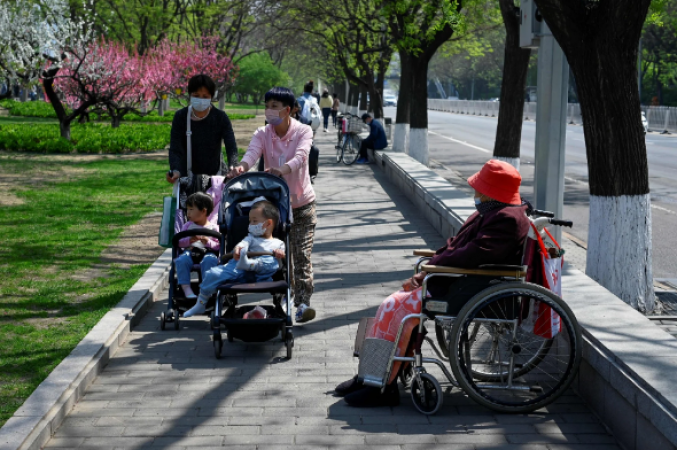
BEIJING: More than a fifth of residents in 13 of China's 31 provincial-level jurisdictions are 60 or older, highlighting mounting pressure on the country's ailing pension system, but highlighting potential growth for the silver economy.
The shocking figures recently made public in a report by Chinese media outlet Yikai may raise concerns among demographers and the government about the problems caused by China's rapidly growing population.
In Shandong, where there are 21.51 million elderly people, or 21.15 percent of the population, there are 10.94 million people who are over 60. In Liaoning, 25.7% of the population is over 60.
According to media reports, most of the provinces in northern China have the highest proportion of elderly citizens. After Tibet and Xinjiang, the largest province in terms of GDP, Guangdong has the third lowest percentage of residents aged 60 or over at 12.73 percent.
China's population over 60 increased from 264.02 million last year to 267.36 million, which is 18.9% of the total.
According to Larry Hu, chief China economist at Macquarie Capital, "aging is likely to be one of the biggest challenges facing China in the next 30 years."
The declining birth rate is making China's population crisis worse. In 2021, 10.62 million babies were born in China, a decrease of 11.5% from 2020.
As a result, the country's total population declined from a growth of 2.04 million in 2020 to just 480,000 last year, reaching 1.4126 billion.
In 2012 there were 882.22 million working-age people in China (defined as between the ages of 16 and 59), or 62.5 percent of the country's total population.
However, the Seventh National Population Census revealed a related pattern. In 2020, there were 894.38 million people in the 15-59 age range, which is 63.35 per cent of the total population, down 6.79 percentage points from the 2010 census.
The public pension system is expected to run out of money within the next two decades as payouts in the low-employee system exceed the contributions of retirees.
Pension shortages are currently only a problem in a few places, such as the Northeast Rust Belt, where youth are leaving due to lack of job opportunities.
One of them is Heilongjiang, which last year reported a deficit of 35.89 billion yuan (US$5.1 billion), according to the National Bureau of Statistics.
According to Hu, when the entire country becomes an aging society in 30 years, given the current aging trend, pension deficit could become a major national issue.
According to a 2019 prediction by the Chinese Academy of Sciences, the urban state pension fund in China is expected to dry up by 2035.
In January, a nationwide pooling of basic pension funds went into effect in response to the risk of loss being experienced by some provinces.
In China, the mandatory retirement age is currently 60 for men, 55 for office workers and 50 for blue-collar workers. However, this year saw a gradual increase in the retirement age.
According to the State Council-affiliated China Development Research Foundation, China is preparing for a huge increase in the demand for elderly care in the coming years as the country's population of over 60 is expected to reach 500 million by the middle of the century.
According to Professor Chen Wei of Renmin University's Center for Population Development Studies, any country with such momentum and scope will face enormous pressure and challenge.
According to Chen, the growing elderly population will put pressure on services for urban senior citizens, who primarily receive government pensions. Older people in rural areas were likely to be more dependent on their families because the welfare system was less comprehensive.
Data released by the Ministry of Civil Affairs last year shows that there is a severe shortage of 20 lakh caregivers for the elderly.
With over 7.9 million beds, there were 220,000 registered nursing homes and facilities for the elderly in 2020.
According to figures released last week by the National Health and Medical Commission, 40 million people are disabled.
According to a 2020 report from the China Research Center on Aging, more than 80% of senior citizens have at least one chronic disease, which can put a significant burden on the healthcare system.
The State Council requested an increase in beds for the elderly by 55% and 9 million nursing home beds by 2025 in the 14th Five-Year Plan for 2021-25.
Over the same time period, it is estimated that the percentage of geriatric medicine departments in level two hospitals – typically located in medium-sized cities or countries – will increase to more than 60%.
While laying out plans to advance the so-called silver economy, which serves senior citizens, the State Council also ordered the establishment of universities and degrees with a focus on elderly services.
According to the "China Silver Economy Industry Research Report in 2021" published by iiMedia Research, elder-related commerce was anticipated to reach 5.9 trillion yuan last year, with an emerging market for health food, senior clothing, and health insurance seen as the main consumer segments.
According to a 2021 report from Tianyancha and Baidu, there are more than 230,000 elderly-related businesses in China, and the industry as a whole has grown by US$6 billion in the last five years.
According to the report, the total market value of Chinese healthcare companies rose by US$66.167 billion from 2020 to US$217.682 billion last year.
Europe "losing" the narrative war against China and Russia
Big Tech's US$95 million lobbying effort could kill the US antitrust bil
Chinese scientists exhume historic ships from the South China Sea's depths